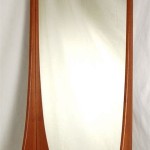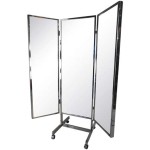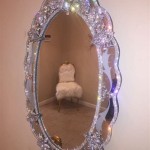Can Convex Mirrors Produce Images?
Convex mirrors, characterized by their outwardly curved reflecting surface, are renowned for their ability to produce images with distinct characteristics. Understanding how these images are formed and their properties is crucial in various applications, from security to automotive design.
Key Points About Convex Mirror Images:
- Always virtual
- Always upright
- Always diminished (smaller than the object)
Unlike concave mirrors, which can produce both real and virtual images depending on the object's position, convex mirrors always produce virtual images. A virtual image is formed when light rays appear to diverge from a point behind the mirror, rather than actually converging at a real focal point. This means the image cannot be projected onto a screen.
Understanding Virtual Image Formation:
- Diverging reflected rays
- Image appears behind the mirror
- Brain interprets diverging rays as originating from a single point
When parallel light rays strike a convex mirror, they reflect outwards, diverging away from each other. The human eye, however, interprets these diverging rays as if they originated from a single point behind the mirror. This perceived point of origin is where the virtual image is formed.
Why are Convex Mirror Images Diminished?
- Wide field of view
- Light rays spread over a larger area
- Resulting image appears smaller
The diverging nature of reflected light from a convex mirror leads to a wider field of view. This wider view comes at the cost of image size. As the light rays spread out over a larger area, the resulting image appears smaller than the actual object. This diminished size is a defining characteristic of images formed by convex mirrors.
The Upright Nature of Convex Mirror Images:
- Reflected rays do not invert
- Virtual image retains the object's orientation
Another key feature of images formed by convex mirrors is their upright orientation. Because the reflected rays diverge and the image is virtual, there's no inversion of the image as seen with certain types of images formed by concave mirrors. The image appears in the same upright orientation as the original object.
Applications of Convex Mirrors:
- Security mirrors
- Automotive side mirrors
- Blind corner mirrors in hallways
The properties of images formed by convex mirrors – virtual, upright, and diminished – make them highly useful in various applications. Security mirrors in shops, for example, provide a wider field of view, allowing security personnel to monitor a larger area. Similarly, the "objects in mirror are closer than they appear" warning on passenger-side car mirrors acknowledges the diminished image size, alerting drivers to the true distance of vehicles behind them.
The Role of the Focal Point in Convex Mirrors:
- Virtual focal point
- Located behind the mirror surface
- Determines the degree of image diminution
While convex mirrors do not have a real focal point where light rays converge, they do have a virtual focal point. This point, located behind the mirror's surface, is where the reflected rays appear to originate. The distance of this virtual focal point from the mirror surface plays a role in determining the size and position of the virtual image. A shorter focal length results in a wider field of view and a smaller image.
Convex Mirrors and Ray Diagrams:
- Parallel ray reflects as if from the focal point
- Ray towards the center of curvature reflects back on itself
- Intersection of projected rays behind the mirror locates the image
Ray diagrams are useful tools for understanding image formation in convex mirrors. By tracing the path of specific rays, one can determine the location, size, and orientation of the virtual image. A ray parallel to the principal axis reflects as if coming from the virtual focal point. A ray directed towards the center of curvature of the mirror reflects back along its original path. The intersection of the projected reflected rays behind the mirror determines the location of the virtual image.
Comparing Convex and Concave Mirrors:
- Convex: Diverging mirror
- Concave: Converging mirror
- Different image characteristics based on surface curvature
The key difference between convex and concave mirrors lies in their surface curvature and the subsequent behavior of reflected light. Convex mirrors, with their outwardly curved surface, diverge light rays. Concave mirrors, with their inwardly curved surface, converge light rays. This fundamental difference in light behavior results in distinct image characteristics for each type of mirror.
Can A Convex Mirror Produce Real Image
Can A Convex Mirror Form Magnified Image Quora
Can A Convex Mirror Produce Real Image When The Object Is Virtual And Vice Versa Concave If Yes How Will It Be Possible Why Quora

Question Recalling Whether The Image Produced By A Convex Mirror Can Be Inverted Nagwa

Can A Convex Mirror Produce Real Image When The Object Is Virtual And Vice Versa Concave If Yes How Will It Be Possible Why Quora
Can A Convex Mirror Form Real Image Quora

Question Identifying The Maximum Size Of An Image Produced By A Convex Mirror Nagwa
Can Convex Mirrors Produce Lateral Inversion Quora

05 Convex Mirrors

A Convex Mirror Always Produces An Erect Real Image Of Diminished Sizean Virtual And Enlarged Sizea Size








